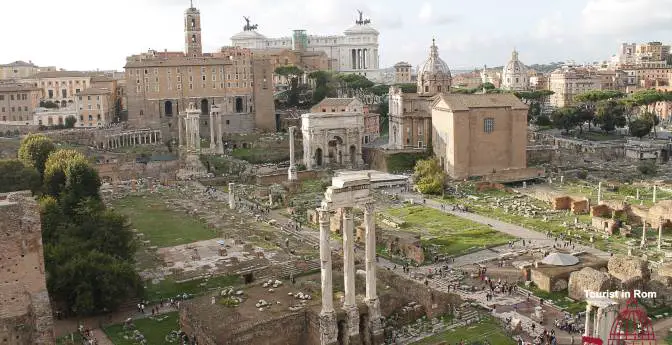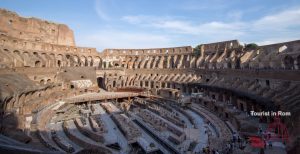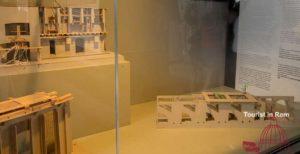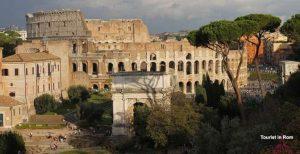Ancient Rome was the center of power in Europe. Visit the ancient sites where the fate of the Roman world was decided.
Around the Palatine, Romulus is said to have founded the city of Rome almost 2,800 years ago. The founding day of Rome is celebrated on the 21st of April. For more than a millennium, the heart of Rome struck here in the territory of the Roman Forum and the Imperial Forums.
Popular tickets and tours
Tiqets
GetYourGuide
In the area of the Archeopark of the Colosseum, traces of the Roman Empire can be found from its origins to its decline. In this area, abandoned after the demise of the Roman Empire, where sheep were grazed and artichokes were cultivated, you can find the traces of antiquity and look back over a period of up to 2,800 years.
Walk along the sacred street, “Via Sacra”, in the Archeopark, and visit the remains of churches and palaces in the area. Visit Nero’s palace, the golden house, the “Domus Aurea”. After Nero’s death it was buried and on its territory, the Coliseum was built. Let yourself be impressed by the sports facilities in the Baths of Caracalla and visit the ancient Roman houses on the Caelius Hill.
Already at the time of Augustus, about 2,000 years ago, Rome was a city of millions. The entire urban area of Rome contains archaeological relics from this period. The Campus Martius, which today houses the city center, was then the area for sports, culture and leisure.
The Capitol
Capitol Hill borders the Colosseum Archaeological Park to the northwest. Between the Capitol and the Palatine Hill was a swamp area, in which the Roman Forum and numerous temples were later built.
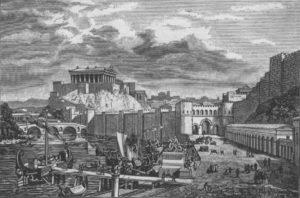
In ancient times, the temple of Jupiter Optimus Maximus was on the Capitol Hill for almost 1,000 years. It was dedicated to Jupiter, Juno and Minerva and was the center of the Roman cult.
A beautiful story is the legend that the chatter of geese in the year 387 BC attracted the Romans and saved them from a night attack of the Gaul.
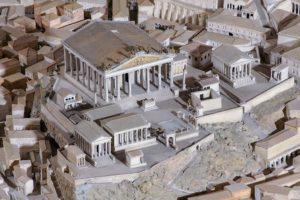
In the Museo della Civiltà Romana in the EUR district there is a model of Rome from the time of the imperial period. It was created by archaeologist Italo Gismondi in more than 35 years of work. Unfortunately, the museum is currently closed for renovations. The museum is documented on Google Arts & Culture: Museo della Civiltà Romana
The Forums – History in 3D
This simulation gives you an idea of what the forums might have looked like.
Above everything, the Temple of Jupiter is resplendent on the Capitol Hill.
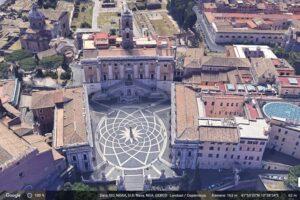
On the hill, the Senatorial Palace of the municipality and the Capitoline museums are located. The square was designed by Michelangelo.
From the Capitol, on the south side you find nice views to the Colosseum, Roman Forum and Palatine Hill, on the west side at Piazzale Caffarelli or the Caffè above, you can enjoy a beautiful view to the Renaissance Rome.
The Imperial Forums
The Imperial Forums belong to the museums of the municipality of Rome. The imperial forums consist of marketplaces and administrative buildings, built by the Roman emperors between 46 BC and 113 AD. You can visit the Forum of Trajan and the Forum of Caesar with the Colosseum Ticket. The entrance is at the Column of Trajan in Piazza della Madonna di Loreto.
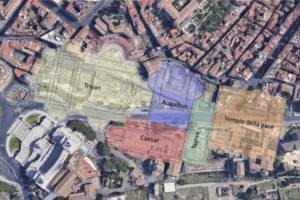
In the 1930s, Mussolini built Via dei Fori Imperiali cross through the Imperial forums, between the Colosseum and Piazza Venezia, and opened it in 1932. On this road he celebrated its parades, he gave his speeches from the balcony of the Palazzo Venezia. A passage under the street connects the Trajan Forum with Caesar’s Forum.
The road is now traffic-calmed and is pedestrian zone on Sunday.
The oldest forum from 46 BC is Caesar’s forum. It is an extension of the Roman Forum and, coming from Piazza Venezia, lies on the right under the Capitol Hill. On the left are the Trajan forums, the Nerva forum and the Augustus forum. The Forum of Augustus from year 2 BC Chr is located before the intersection of Via dei Fori Imperiali and Via Cavour. Further in direction of the Colosseum are Emperor Domitian’s Nerva Forum from 98 and the Temple of Peace, which was built under Emperor Vespasian in 75. In the years 112 and 113, Emperor Trajan built his Forum and the markets.
The column of Trajan – History in 3D
At the end of the Trajan Forum is the Trajan Column, on which the history of the Dacian Wars is depicted.
The Dacians lived in the Carpathians in what is now Romania and the wars ended with the victory of Rome and the annexation of the territories.
Inside the column leads up a spiral staircase, which is not open to the public. In 1587, a bronze statue of St. Peter was placed at the top. 200 years later, Johann Wolfgang v. Goethe reported on the priceless view he enjoyed from up there.
Roman Forum and Palatine Hill
The Palatine Hill is one of the seven hills of Rome, and the oldest, since the 10th century BC populated part of Rome. Legend has it that Romulus founded his city here. The Roman Forum joins in the North. After the end of the 7th century BC the wetland was dried, it became the center of Roman public life for more than 1,000 years. The Palatine is thus the cradle of Rome, while life pulsated in the Forum and later in the Forums.
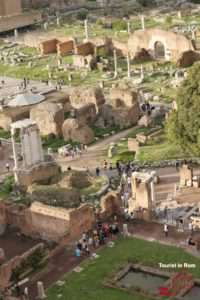
There were temples and public building in the Roman Forum. Among other things, the Venus Temple, the Temple of Vesta and the House of the Vestal Virgins are located here.
To the south of the Palatine you can see the Circus Maximus from the ruins of the Imperial Palace – Domus Augustana. On the left you can see the building of the UN organization FAO – Food and Agriculture Organization – and behind it the baths of Caracalla.
Some archaeological sites and the museum on the Palatine can be visited only with the so-called SUPER Ticket. The SUPER Ticket is included with the ticket for the Arena of the Colosseum.
There are several entrances to the area. Next to the entrance in Via di San Gregorio you can see the remains of the aqueduct of Claudius, which distributed 2 cubic meters of water per second in the metropolitan area of Rome coming from the Aniene valley, 42 miles away.
The stones, statues and ruins in the forums attract especially historians and archaeologists. Of course, it is also interesting for mere mortals to know where the House of the Vestals, the Temple of Caesar, other temples, trading places and basilicas were located. But especially in the summer heat it is more pleasant on the Palatine, where, in addition to archaeological finds, there is a lot of greenery and shade, a small garden and, above all, magnificent viewpoints.
The Colosseum
Where the artificial lake was located in front of the Domus Aurea, the Colosseum was built. At the entrance of the golden house there was a colossal statue of Nero. The statue was redecorated to the Sun God and placed in front of the Colosseum.
You can find a lot of information about this at the links at the bottom of the page.
Meta Sudans
The Meta Sudans was an ancient monumental fountain. It consisted of a 17 meter high cone with a diameter of 7 meters at the base, which stood in a water basin with a diameter of 16 meters. The base is still visible today in front of the Arch of Constantine.
Mussolini had the remains of the well dragged to make room for his marches. At that time he also had the Via dei Fori Imperiali built, with which he boarded from the Colosseum to Piazza Venezia right through the imperial forums.
You can see the Meta Sudans fountain and the colossal statue of Nero very well in this simulation.
Domus Aurea
The Domus Aurea is situated above the archaeological area of the Colosseum, Fora and Palatine in the underground of the Oppius hill.
Emperor Nero has built his Golden Palace after the fire of Rome in the year 64 on an area of approximately 80 hectares. The remnants were rediscovered in the 18th century in the underground of the Colle Oppio. They are currently being restored.
The Romans built villas only in the countryside, where land cost little. They felt a waste that Nero had his villa built right in the center of Rome and they resented it. After the death of the much-hated Emperor Nero the Palace was filled up and thermal baths were erected. The rest of the area was assigned to other purposes. So, for example in the area of the Colosseum, before were an artificial lake, which belonged to the Palace of Nero. The Domus Aurea can be visited only by reservation. Using virtual reality, you can discover what the palace once looked like.
In 2015, a space on the Colle Oppio was devoted, to the delight of the Lutheran parishes in Rome, the reformer Martin Luther.
Going on from the Colle Oppio in a northerly direction you will reach the Basilica of Santa Maria Maggiore and farther to the main train station Termini.
The Caelius Hill
The Caelius hill has a special charm. Although it is in close proximity to the Colosseum, it is outside the tourist flow. At the top of the hill is the somewhat dilapidated Villa Celimontana and right next to it is the highly interesting circular church Santo Stefano Rotondo.
The pompous wedding church of Saints John and Paul is on the descent towards Circus Maximus. Their apartments are under the church. You can visit these “Case Romane del Celio”. You can find more details in our article Caelius and Oppius in half a day.
Circus Maximus
The Circus Maximus is located in the valley between the Palatine and the Aventine and was the largest venue in ancient times with space for 150,000 spectators. With a length of 600 m and a width of 140 m, it is still used today for the annual New Year’s Eve celebrations. Exhibitions, events and large concerts take place here. The Rolling Stones and many others gave concerts here.
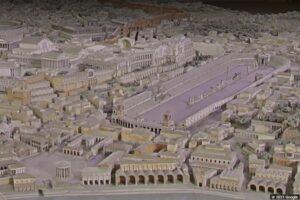
The history of the circus began with the founding of Rome. Romulus invited the neighboring peoples to a big festival and robbed their wives – the robbery of the Sabine women took place here. Over time, grandstands were built and the circus continued to expand. Mainly horse races and chariot races took place in the huge square.
Fires broke out more frequently in the wooden booths and so the circus gained dubious fame. The origin of the great fire of Rome in 64 under Emperor Nero, in which Rome was largely devastated and thousands of people died.
From the 6th century the area was used for agriculture and only in modern times has it been used for events from time to time.
The baths of Caracalla
From the Circus Maximus, you can go to the South in the direction of the catacombs on via Appia Antica and you’ll have the baths of Caracalla on the right side.
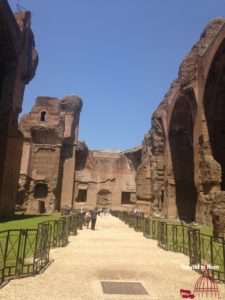
Built in less than thirty years in the 3rd century AD they’re one of the largest swimming and sports facilities of ancient Rome. The operation of the spas with their enormous need for water and fuel was a logistical feat.
In this simulation you can see what the thermal baths of the Caracalla once looked like.
The Romans undoubtedly knew how to enjoy life.
The baths of Caracalla – History in 3D
